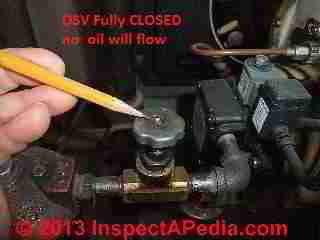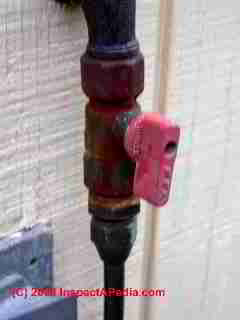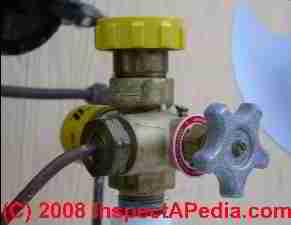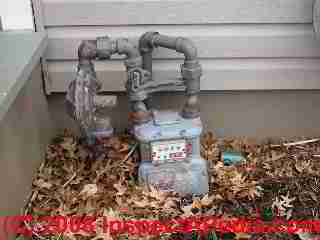 How to Turn OFF Electrical Power & Fuel for Oil or Gas Heating Equipment
How to Turn OFF Electrical Power & Fuel for Oil or Gas Heating Equipment
- POST a QUESTION or COMMENT about how to turn off oil or gas fired heating equipment
How to turn off electricity & oil or gas fuel to heating equipment. This article describes how to turn off heating equipment in an emergency or if the equipment does not turn off in response to normal thermostat controls.
We describe first turning off electrical power and next turning off oil or gas fuel supply to the equipment. You may use these same controls when shutting down a building's HVAC equipment in an emergency or under other conditions. We include important safety warnings when performing heating equipment shutdown.
InspectAPedia tolerates no conflicts of interest. We have no relationship with advertisers, products, or services discussed at this website.
- Daniel Friedman, Publisher/Editor/Author - See WHO ARE WE?
How to Turn Off Electricity & Fuel Supply to Oil or Gas Fired Heating Equipment
 In an Emergency, if you can safely do so, turn off electrical power to the Heating or Cooling Equipment.
In an Emergency, if you can safely do so, turn off electrical power to the Heating or Cooling Equipment.
The places to do this are at the Emergency OFF electrical switch (usually the switch plate is red) located outside of the boiler or furnace room, usually on a wall near a doorway. In many homes this switch is located at the top of a basement stairwell;
Often a second electrical switch is also located right at the heating equipment.
The heating equipment should STOP immediately.
In an emergency, if turning off electrical power does not stop an oil or gas fired heating unit, and provided that you can safely approach the unit (there is no fire or smoke)
you should turn off both electrical power AND the fuel supply to the equipment.
Below in this article we explain how to turn off the heating oil or gas fuel supply to heating equipment.
 In some buildings the electrical ON/OFF switch for the heater may be an older fuse panel such as the box shown at left.
In some buildings the electrical ON/OFF switch for the heater may be an older fuse panel such as the box shown at left.
But if the building is on fire or smoke-filled, slowing down to look for equipment switches or approaching equipment that is glowing red, smoking, on fire, or otherwise scary is dangerous and should not be attempted. Instead you should get out of the building and call for help.
Watch out: If you cannot safely turn off heating equipment in an emergency you should immediately get everyone outside of the building and then from another location call your local fire department for emergency assistance.
Then call your heating or air conditioning service company for further diagnosis and repair help.
Details about this switch are at ELECTRICAL POWER SWITCH FOR HEAT
Immediate LP or natural gas safety hazards: if there is evidence of an LP or natural gas leak at a building, gas odors, for example, you should:
- Do not do anything that is likely to cause a gas explosion, such as lighting a match, operating an electrical switch, or even using a telephone in the building
- Leave the building immediately and keep a safe distance away - 100 feet or more.
- Notify other building occupants of the safety concern
- Contact the local gas company and/or fire department
Heating equipment which the building owner, occupant, or inspector judges to be an immediate life safety hazard should be shut down and appropriate emergency services called.
Watch out: Don't cycle the heating or cooling equipment electrical ON and OFF rapidly using the electrical power switch or any other control. For heat, wait at least five minutes between on-off cycles; for cooling wait at least fifteen minutes to minimize the risk of equipment damage.
How to Turn Off Fuel Supply to Oil or Gas Fired Heaters
What if Oil or Gas Fired Boiler or Furnace Keeps Running Even with Power OFF?
Watch out: oil or gas fired hot water or steam heating equipment may fail to shut down even if electrical power to the equipment is turned off.
We found this situation at an old oil fired heating boiler in Poughkeepsie, New York. Even after turning electrical power off, we observed that a smoky flame continued indefinitely at the oil burner. It was pretty unnerving to see that oil burner continue to fire away even after we had turned electrical power off. The oil burner motor stopped, but the fire chamber was red hot, enough that as oil continued to feed out through the oil burner nozzle the fire just continued.
The problem was a failed check valve in the oil burner's fuel unit, combined with gravity-fed oil to the heating system.
Turning Off the Oil Line Valve - the OSV or Oil Safety Valve
For oil fired heating equipment if the oil safety valve is turned fully clockwise (right to left), it is moved to its closed position and oil cannot flow (photo below).
This valve includes a fusible link or stem that is designed to melt and thus allow a spring to snap the valve shut in the event of a fire.
An added cautionary note if you had flooding in your home or on your property: if you have a fuel oil or propane tank, it may have floated and broken the connecting pipes. Even an underground tank can float.
There is so much confusion about which way to turn this valve that we've gone over it ad nauseum at OIL SUPPLY LINE SAFETY VALVE TURN DIRECTION to OPEN or SHUT. Details about oil line shutoff valves, oil safety valves or OSVs are at OIL SUPPLY LINE SAFETY VALVES, OSVs.
Turning Off the LP or Natural Gas Line Valve
For gas fired heating equipment, codes require a shutoff valve outside of the equipment cabinet; the valve is usually a lever, in which case if the lever is at right angles to the piping the valve is OFF and gas flow will stop. In our photo below the red gas valve control lever is parallel to the LP Gas line and thus is in the OPEN position - allowing gas to flow.
If the gas valve is a round handle that looks a bit like a water shutoff valve, turning the valve fully clockwise (right to left) is off, just as with water valves.
In our photo above, the blue-gray colored handle at the right side of the image is the main gas valve on this LP gas tank. To CLOSE this gas valve turn it all the way in or clockwise. Don't be confused by that yellow cap - that's used by the LP gas delivery driver to fill the LP tank.
Some gas meter valves will have a hole in the handle. This hole lines up with a hole in the valve body when the gas is shut off. (The gas company uses the hole to lock or seal the valve closed when the building is vacant.) When the holes are lined up, you know that the gas supply has been shut off.
How to Confirm that Gas is Turned Off?
If in doubt, and to be sure that the gas is off, write down the numbers on all the dials in the meter. Check the dials at least five minutes later. If the numbers have changed, the valve is not closed. Gas is still flowing. Telephone your utility company for help and keep clear of the area until the gas has stopped flowing.
Above we show a gas meter located outside the building; just about every gas meter installation will include a gas line shutoff valve on the incoming gas line. The gas company tells us not to touch this valve, but honestly, in an emergency we've seen emergency workers not hesitate to use a tool to carefully close the valve.
Watch out: never force a stuck oil or gas fuel valve. If you break it and cause a leak you've probably caused a big catastrophe, possibly an explosion or fire. We can understand the gas company's position in this matter.
Remember: if you have gas appliances that were flooded, you will need to clean the mud out of the pilot and the burners.
Details about gas shutoff valves are at GAS SHUTOFF VALVES, LP or NATURAL or select a topic from the closely-related articles below, or see the complete ARTICLE INDEX.
...
Continue reading at OIL SUPPLY LINE SAFETY VALVE TURN DIRECTION to OPEN or SHUT or select a topic from the closely-related articles below, or see the complete ARTICLE INDEX.
Or see these
Recommended Articles
- A/C - HEAT PUMP CONTROLS & SWITCHES
- AIR HANDLER or BLOWER FAN WON'T STOP
- BOILER CONTROLS & SWITCHES
- ELECTRICAL POWER SWITCH FOR HEAT
- FIRE SAFETY CONTROLS
- FURNACE CONTROLS & SWITCHES
- GAS SHUTOFF VALVES, LP or NATURAL
- GAS WATER HEATER AUTOMATIC SHUTOFF
- HEAT WON'T TURN OFF
- OIL SUPPLY LINE SAFETY VALVES, OSVs
- OIL SUPPLY LINE VACUUM-ACTIVATED OSVs & PRVs
- OIL SUPPLY LINE SAFETY VALVE TURN DIRECTION to OPEN or SHUT
- STEAM HEATING SYSTEMS & CONTROLS
- THERMOSTAT WON'T TURN OFF
- THERMOSTAT WON'T TURN ON
- THERMOSTATS, HEATING / COOLING
Suggested citation for this web page
OIL or GAS FUELED HEATING EQUIPMENT SHUTOFFS at InspectApedia.com - online encyclopedia of building & environmental inspection, testing, diagnosis, repair, & problem prevention advice.
Or see this
INDEX to RELATED ARTICLES: ARTICLE INDEX to HEATING OIL, OIL BURNERS, OIL FIRED HEATERS, OIL TANKS
Or use the SEARCH BOX found below to Ask a Question or Search InspectApedia
Ask a Question or Search InspectApedia
Try the search box just below, or if you prefer, post a question or comment in the Comments box below and we will respond promptly.
Search the InspectApedia website
Note: appearance of your Comment below may be delayed: if your comment contains an image, photograph, web link, or text that looks to the software as if it might be a web link, your posting will appear after it has been approved by a moderator. Apologies for the delay.
Only one image can be added per comment but you can post as many comments, and therefore images, as you like.
You will not receive a notification when a response to your question has been posted.
Please bookmark this page to make it easy for you to check back for our response.
Our Comment Box is provided by Countable Web Productions countable.ca
Citations & References
In addition to any citations in the article above, a full list is available on request.
- In addition to citations & references found in this article, see the research citations given at the end of the related articles found at our suggested
CONTINUE READING or RECOMMENDED ARTICLES.
- Carson, Dunlop & Associates Ltd., 120 Carlton Street Suite 407, Toronto ON M5A 4K2. Tel: (416) 964-9415 1-800-268-7070 Email: info@carsondunlop.com. Alan Carson is a past president of ASHI, the American Society of Home Inspectors.
Thanks to Alan Carson and Bob Dunlop, for permission for InspectAPedia to use text excerpts from The HOME REFERENCE BOOK - the Encyclopedia of Homes and to use illustrations from The ILLUSTRATED HOME .
Carson Dunlop Associates provides extensive home inspection education and report writing material. In gratitude we provide links to tsome Carson Dunlop Associates products and services.




